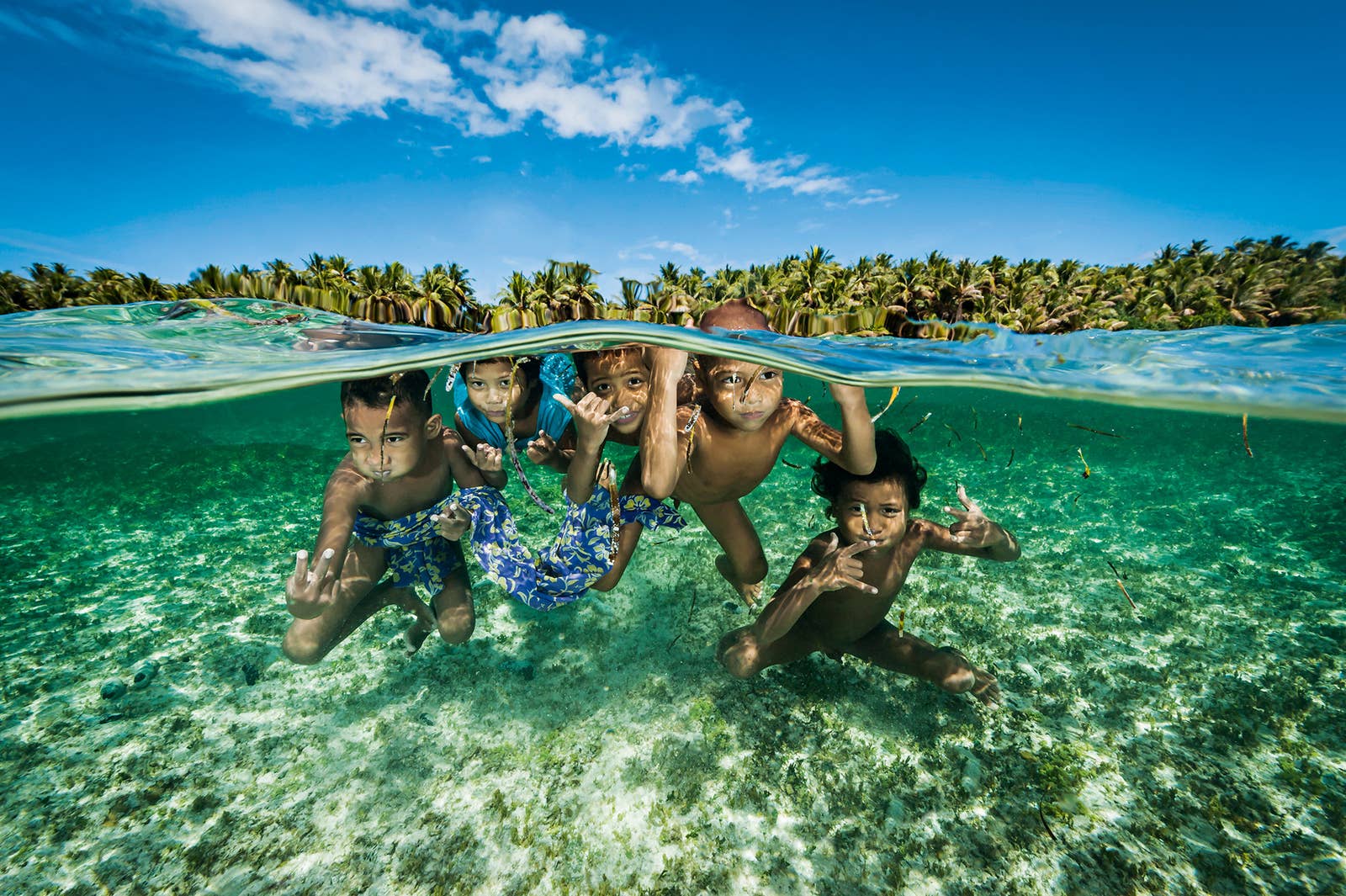
The ocean may truly be the final frontier — despite a long maritime history, we have only just begun to explore the waters that cover 70% of the globe. What lies beneath the surface, as opposed to at the edge of the horizon, has been a constant source of fascination for David Doubilet, a longtime underwater photographer.
Over the course of 50 years with National Geographic, Doubilet has pioneered the split-frame image showing both above and below the water’s surface in a single frame. His work examines the connection between the two worlds, proving a remarkable insight into the impact that humans have on a realm we know little about. A collection of his favorites is now available in a new book, Two Worlds: Above and Below the Sea, and he took the time to talk with us about what it’s like to shoot film underwater and why these pictures matter so much now.
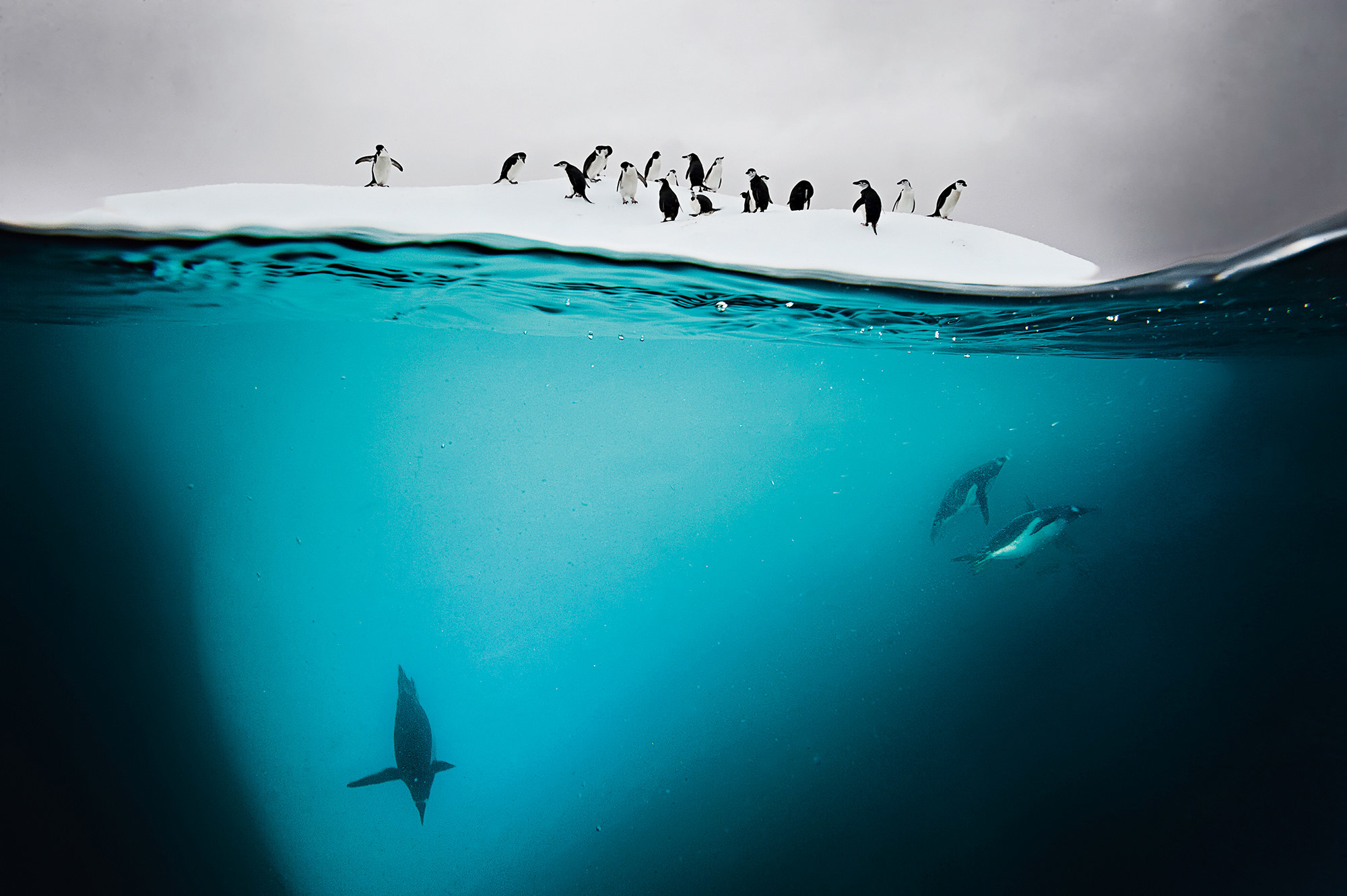
How did this get started?
What I love about this is that the surface of the sea is the most important border on our planet. It divides the air world, the known world where we all live, and the water world, which, up till the last 75 years or so, has been something of a mystery. Underwater photographers really have been trying to connect people with the ocean.
These half-and-half images are my favorite images to make. It began with a vision that I had when I was around 9 years old, swimming around the jetty of the Ocean Beach Club in New Jersey. I would swim with my head above the water and see the lifeguard blowing his whistle at me, screaming. I'd see people on the beach, I'd see clouds passing by. I'd see a whole different world. And I put my head just below and here's a silent, welcoming world full of shafts and green light and fish hiding beneath the boulders of the jetty, waving seaweeds, groups of passing fish. It was the boundary of Two Worlds.
Fast forward to a five-decade-long career as an underwater photographer and storyteller for National Geographic magazine. It's been an incredible partnership that has provided the perspective of time in the sea and a platform to show the world these pictures, and at the same time, promoting curiosity, exploration, discovery, and creativity. When I began working underwater, I thought the oceans were infinite… I was wrong; they are fragile and finite. Over time, the story coverages started with discovery, and now we are circling back to conserving those discoveries — something I did not expect in my lifetime.
A part of the storytelling is to find an image that distills a sense of place in one frame. For me, that image is the half-and-half image — the one that connects the surface to the hidden world below. It is a joy to look for and make these photographs. Not every assignment produces a half-and-half picture, but I scout for them endlessly. Some succeed and some do not. I like the artistic and technical challenge of making them.
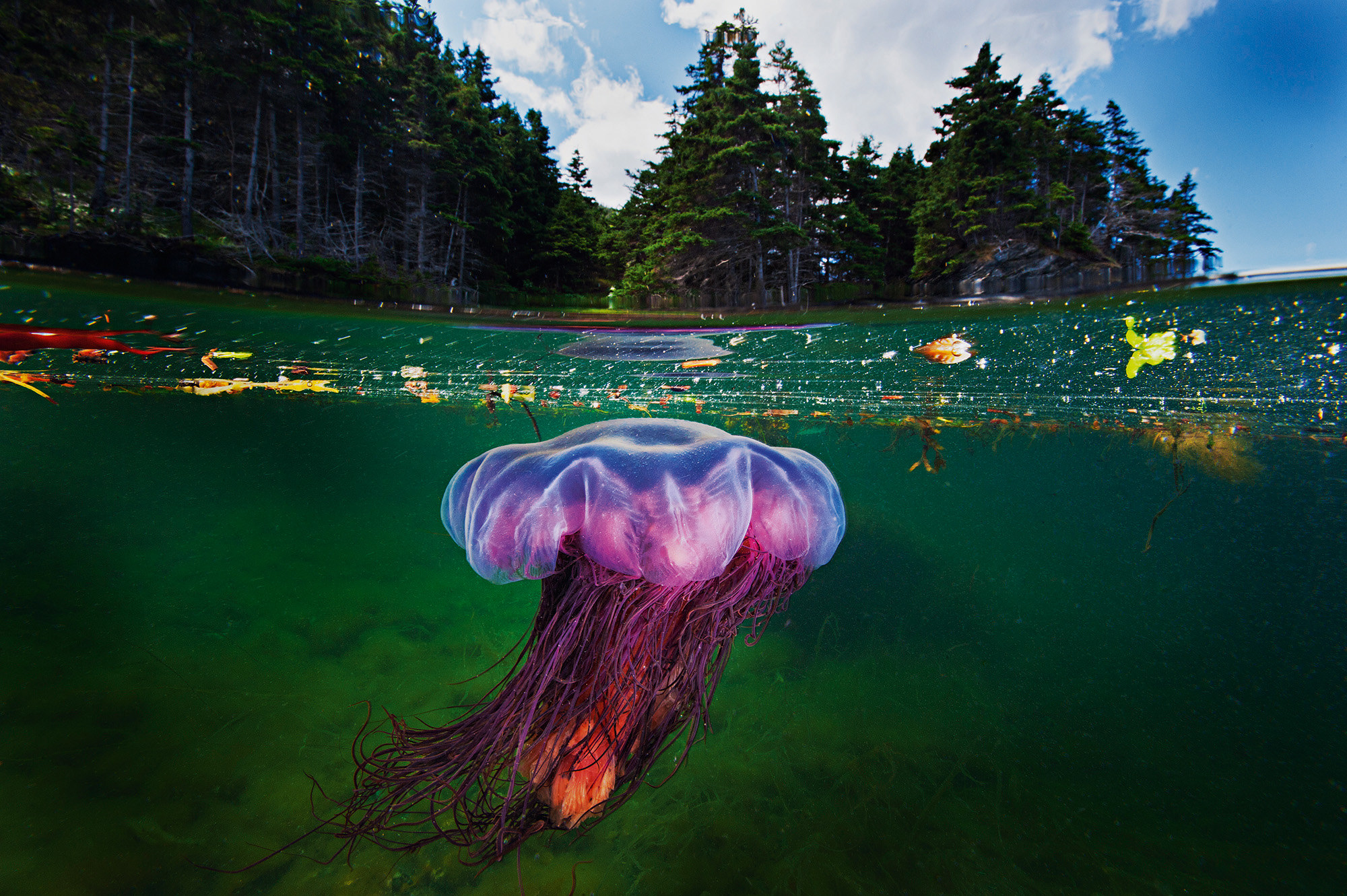
Can you talk about that a little?
You have to use a camera with a super wide-angle lens and large round dome in the front, which corrects for the magnification of water. This original concept and design can be attributed to National Geographic photographer Bates Littlehales.
The first challenge: to light for the underwater half using submerged strobes. The next hurdle is focus in both surface and subsurface worlds. Shooting at highest f-stop helps accomplish this. And then there are the dreaded water droplets. There are always unwanted droplets that will appear in the image right where you do not want them to. You can rinse the camera dome repeatedly, use Rain-X, your own spit, a potato — yes, a potato — or in my case, I use toothpaste wiped on the dome and rinsed off. But by far the biggest challenge of all is finding that place that tells a story about two worlds in one frame.
You learned to photograph underwater on film, and you still encourage photographers learning to dive to start with black and white. Can you talk a little bit about what it's like working underwater?
First of all, before digital, you had 36 exposures, and that's it. That's all you got [on a roll of film]. No one in their right mind would go underwater right now with a card that has only 36 pictures.
Number two, underwater, you can't change lenses. And number three, you can't see what you're shooting, which is the most important. As my friend Jay Maisel would say, you shoot as much as you can, because paranoia pays. And finally, there's focus, you know, everything underwater is one-third larger. So that's what these big domes correct, and that's what some of the special wide-angle lenses correct for.
With technology now, you get moments that you couldn't get before. When you're underwater, a lot of things happen with color. First of all, red disappears in literally a foot of water. If you go diving, a red shirt is red in the first foot of water; by like 10 feet, it's kind of a maroon, by 60 feet, that red is black. And this is in clear, beautiful Caribbean or mid-Pacific water. So to restore the spectrum, you can now take down a strobe — we call it a bottle of sunlight — and you illuminate the side of a reef system. A black sponge then turns out to be brilliant crimson.
You have to be careful shooting — you just don't want to tramp on everything — but the closer you are to something, the more brilliant the pictures are.
As far as marine mammals go, they're in charge, they'll either accept you or reject you. You're not gonna scare a whale away because you're in the water. The whale is gonna move and leave or they'll come right by you and ignore you. Or the whale will look in your eye. I've had a turtle basically follow me all over, over a reef system, so much so that he would put his flippers around my tank and look over my shoulder, and it's me and the turtle.
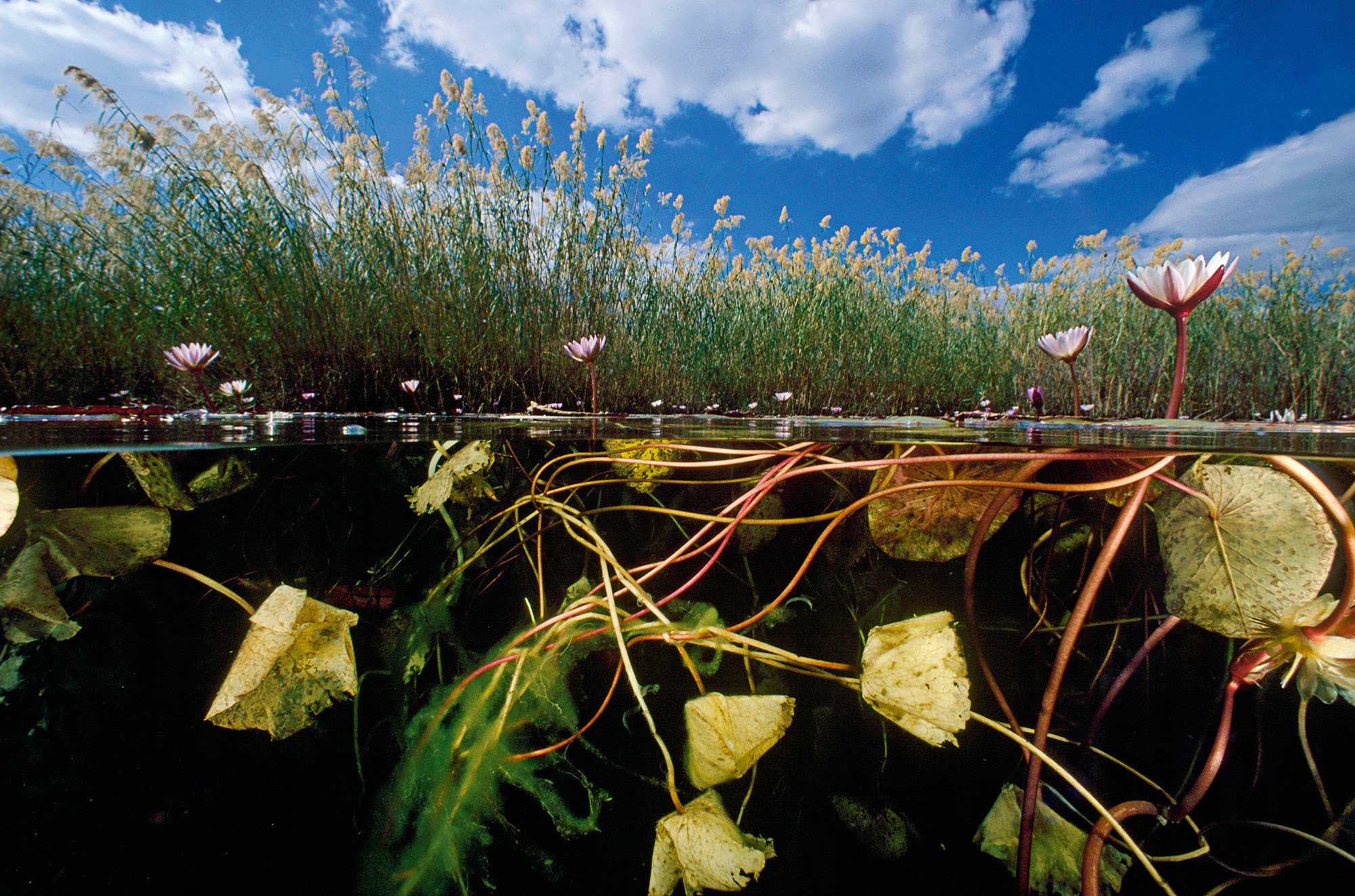
That's amazing. Can you talk a little bit about why this vision of above and below is particularly important now?
We are in a time and a place on this planet where everything is changing. It's not just climate change that is affecting the oceans… there is overharvest, habitat destruction, and coral disease. We are at a crossroads, a time where we have to stop talking and start doing. I really just have a single goal: Connect people to the sea.
I mentioned before that the best thing that National Geographic has given me is the perspective of time in the sea. It's the most valuable thing that I can imagine. I decided to put that to work.
As an example, it occurred to me that after five decades in the sea as a journalist, I have an archive that is basically the ocean through the lens of time. We now know that corals are a thermometer for the oceans and that temperatures are rising, causing loss of corals around the planet… But what does that really look like? I decided to go into my archives to locate healthy reef pictures and return to that exact same spot on the reef after severe coral bleaching events. I returned to the Great Barrier Reef and Guam. The mission was to create powerful pairs of before and after coral bleaching images that show a healthy reef then and coral cemeteries now… pairings that wake people up. Tumon Bay, Guam, appears in the book. We photographed there in 2005 and came back and photographed in 2017 after three years of coral bleaching. Coral bleaching happens when heat causes stress that in turn causes the coral to expel beneficial algae that also gives coral nutrients and its color. The triple bleaching event in Guam was extreme and the coral did not survive. The effect is alarming.
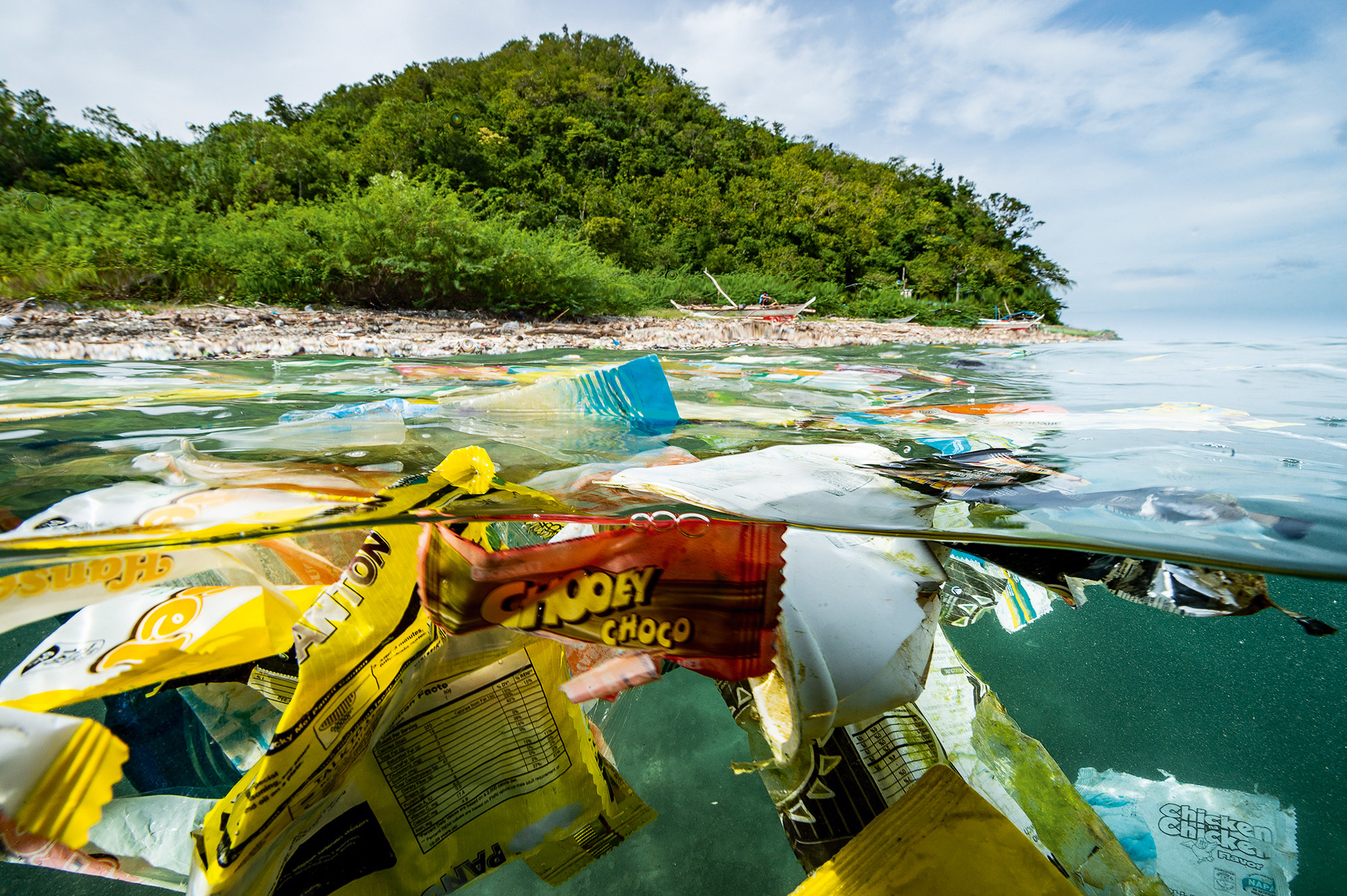

Can you talk a little bit about how diving has changed over the last 50 years? Like there's obviously been bleaching events, but then are there other elements that have changed either in terms of technology or in terms of what you're seeing?
The reefs have changed wildly in the [past] 50 years or even 60 years. I first saw a coral when my father took me down to the Bahamas when I was 12 years old. The coral reef was made up of these great forests of elkhorn coral, which is brown, wonderful-looking coral [that’s] kind of almost the redwoods of a good coral world. And beneath that waft endless schools of fish, and throughout the Caribbean, that's what it used to look like. Now 90% of the elkhorn has vanished throughout its range.
But there are a few places where it hangs on and even thrives: The Gardens of the Queen, an archipelago 50 miles off the southern coast of Cuba where it survives because of a wonderful combination of geopolitics and geography. Fidel Castro had a great interest in the sea because he was a diver and he had foresight to preserve some areas. Now this corner of the Caribbean off Southern Cuba is a time capsule in the sea.
Yes, we must tell the hard truths about the challenges, but there is hope and resilience. Some corals survive the coral bleaching to reproduce, creating more heat-tolerant corals. We see effective conservation measures with the creation of Marine Protected Areas, UNESCO World Heritage Sites, and National Parks. We see shark sanctuaries like the Bahamas and Palau, where sharks are celebrated and considered valuable to both the economy and the environment.
Can you talk a little bit about how geopolitics and the ocean interact?
We have seen the greatest conservation wins where the conservation involves the community. They are sometimes called community-based marine protected areas, and we see them functioning very well in some areas of the Coral Triangle: the Philippines, Papua New Guinea, and Indonesia.
In some areas, it comes down to aggressive protection from poaching through eyes on remote reefs 24/7/365. An example of this is the Philippines’ coral crown jewel: Tubbataha Reefs Natural Park. Remote atolls in the center of the Sulu Sea. Accessible to diving tourists for only a few months, rangers reside on the reef 365 days a year guarding against poaching.
It's heartbreaking in a way how much has been lost. Um, and in some ways the photos are all that's left, which is also a little crazy to think about.
Final thoughts?
When I began diving, every dive was a voyage of discovery. It still is. Every time I go on the water, it's still something exciting. However, now we are documenting the time in a place, and it may disappear. So it's different; we're also hopefully celebrating places that are going to be successful. As a journalist, this is telling the most important story on a planet and is ongoing. The greatest show on Earth is Earth itself.
Yes, the oceans are in trouble and our individual choices collectively make a big difference. We all rely on the sea for oxygen and other resources… we are stakeholders, and we should protect what is at stake whether we live on the coast or inland. I see incredible hope in #NextGenOcean and collaboration.
This book documents the largest, most important border on the planet… the surface of the sea. It is an invitation to know, understand, and protect the other 71% of planet Earth…
As the oceans go, so do we.

UPDATE
Jay Maisel's name was corrected in the text.
